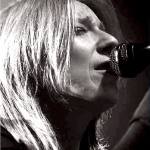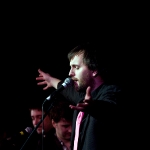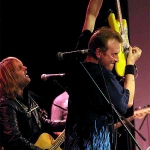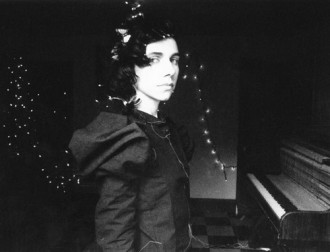PJ Harvey & John Parrish…
Between 1994 and 1995, he co-produced and played on the PJ Harvey album To Bring You My Love, and joined her band on tour. In 1996, after Polly heard music John had written for a production of Hamlet and asked him whether the two of them could work on music that was as exciting and convention-breaking, the pair of them collaborated on the aforementioned Dance Hall At Louse Point. Towards the end of the 1990s, John was a featured musician on the Is This Desire? album and subsequent tour. And eventually – after eight or so years during which he and Polly recurrently sought each other’s opinions about their ongoing musical projects and ideas – he took up the same co-production role on 2007’s White Chalk, the album that many people see as Harvey’s most perfectly realised album thus far.
“With every record that Polly’s made, and every record that I’ve made,” says John, “we’ve been sending each other stuff and talking about what we’ve been doing. Everything we do – to some degree – is a collaborative effort.”
“I always ask for John’s opinion on whatever I’m doing, even if he’s not involved,” says Polly, “So during the years when I made records where he’s not been there, I’ve still been sending him every single demo I do, and I want his opinion of the songs. I’ve always valued his judgement on whether anything’s any good or not.”
A Woman A Man Walked By first stirred in the summer of 2006, when Harvey was completing the writing of the songs that would make up White Chalk. “I stumbled across a piece of music that we’d had floating around from about five years before, that we’d done nothing with – and that became Black Hearted Love,” she says. “I’d written the lyric to it, and we’d never recorded it. I said, ‘That song’s really fantastic – can you write another nine songs so we can make an album?’ That’s pretty much how it happened.”
At root, what fires this partnership is simple enough: that each brings talents and qualities to the creative process that working alone rules out. To take things down to the bare bones, Polly sings and writes the lyrics, and John composes the music, plays most of it, and takes charge of the arrangements – though behind that division of labour lurks a real empathy and shared intuition.
“Polly, vocally, is far more adept than I am, and that frees me up to write much more extravagant music, because I know that she’s capable of matching it,” says John. “If I was to write something for myself to sing, it would have to be much simpler, much more straightforward. For me, it’s a liberating process – because I feel I can write pretty much anything, and throw almost anything at her, and something interesting’s going to come back.”
“We both play and perform with the same feeling,” says Polly, “so it’s completely natural for me to feel the music that he’s written. But John comes up with music I could never come up with – I’m just not as adept as he is on many different instruments; I just wouldn’t be able to come up with that intricate a sound. I use an instrument as a tool to sing the song over, but I can’t go much further than that. Whereas I think the music that John makes is just so full of melody and rhythmic changes and all these things that it’s very exciting for me to construct lyrics over that. I come up with ways of singing, and words, that I never would if I was left to my own devices.”
Behind the combination of words and music, there lies a fascinating combination of accident and design. On this record, for example, the music for three songs – 16.15.14, The Chair and A Woman A Man Walked By – came with ready-made titles from John, which either sparked Polly’s imagination or pointed towards already-written lyrics that had accidentally suggested similar themes.
“As a lyric-writer, I’ve changed quite a lot over the years,” she says. “These days, I tend to work on words very separately from music. I like to make them work on the page. I keep books and books of finished lyrics – and with this record, I would listen to the music and see what it suggested, and I’d know where I could reach for in my lyrics, and think, ‘Oh yeah – that.’ But also, John would sometimes come up with a title, which was really exciting. I was given a piece of music, and it was called 16.15.14, and immediately, I was thinking, ‘You’re in the garden, playing hide and seek.’ My mind just goes straight away. I love it when that happens.”
|
|

|

Bellowhead |
LATEST GALLERY IMAGES

Mike Peters Remembered 
"I Don't Like Mondays..." |
|
|


